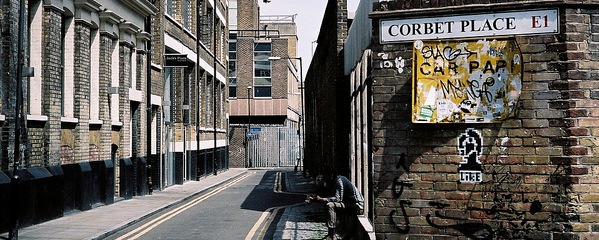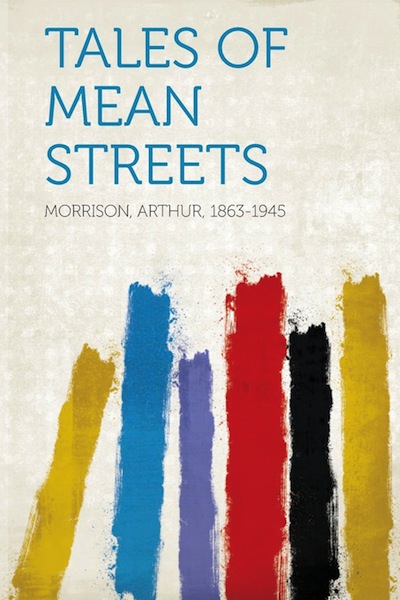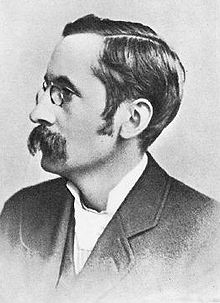
photo © Dominik Morbitzer, 2011
by Mike Smith
There is a ‘Dickensian’ whiff to Arthur Morrison’s writing. His short stories appeared a decade before the First World War and there is a brutality about his version of East End London, and about his writing style, that I didn’t expect to find in a writer of the Edwardian period.
The baker’s dozen of stories in his collection Tales of Mean Streets starts with the depressingly violent and unredeemed ‘Lizerunt’. The title is the compressed name of the main female character, who has been wooed, married, beaten, and sent into prostitution by the male lead, Billy. The name made me think of lizard and runt, and so did the miserable lives of the protagonists. Violence – usually, but by no means exclusively against women – pervades this story, and the collection, which I read over a couple of days. Morrison’s characters are ground down remorselessly, but he focusses on the choices they make. It is not only the ‘accidents of heredity’ that doom his East Enders. It is the way they respond to them. Over the collection as a whole, there is a slowly emerging pattern: that of the failure of his characters to escape from their situations. Billy, from ‘Lizerunt’, is totally incapable of looking after himself. Elizabeth Hunt may be helpless against his violence, but she is not helpless otherwise. He is, though. The only power he has is to compel her, by threats and beatings, to earn the money that sustains his miserable existence.
This is the most inward looking, and perhaps most powerful of the stories, and it dominates and validates the collection. The other stories move further away, into a journalistic style of detachment: tramps steal from their peers, rather than supporting each other, in ‘Without Visible Means’; ‘To Bow Bridge’ takes us on a documentary tram ride; in ‘Behind the Shade’, two women starve to death behind a mask of genteel respectability; and ‘On The Stairs’ sees a woman who allows her son to die, rather than spending money on treatment, thus enabling her to afford a showy East End funeral. Appearances and social pressures from within their own class, Morrison is saying, hold these people back. As legatees, shopkeepers and landlords, they also fail, through their own and their neighbours’ preconceptions about what those statuses imply, and demand.
 Morrison was, in a sense, a self-made man, in that he escaped from the mire in which his characters struggle. He became a journalist and, later, became a seller of oriental prints that he bought from sailors returning from the far east. During this period of his life he was reluctant to own his origins. It is perhaps not surprising, then, that the eye he turns upon his ‘mean streets’ sees their citizens as victims of their own inadequacies, rather than of the injustices of the wider world. To some, this must seem an unsympathetic gaze – the brutality certainly shocked his contemporaries – but we are used to brutality now, fictional and documentary. How should we see these stories?
Morrison was, in a sense, a self-made man, in that he escaped from the mire in which his characters struggle. He became a journalist and, later, became a seller of oriental prints that he bought from sailors returning from the far east. During this period of his life he was reluctant to own his origins. It is perhaps not surprising, then, that the eye he turns upon his ‘mean streets’ sees their citizens as victims of their own inadequacies, rather than of the injustices of the wider world. To some, this must seem an unsympathetic gaze – the brutality certainly shocked his contemporaries – but we are used to brutality now, fictional and documentary. How should we see these stories?
‘Three Rounds’ is a ten page bruising, as Neddy Milton, underweight and underfed, but carrying a half pint of ‘four-ale’ and half a greasy sausage roll uncomfortably in his belly, prepares for, and endures, the eponymous three rounds against Patsy Beard. It’s a competition bout that Neddy hopes will launch him on a boxing career. There’s a compelling inevitability about the story. We know that Neddy isn’t up to it and we know he’ll get a beating, and that’s only giving away what you would have guessed from the first half page. The language is direct, like the boxing.
Neddy Milton was not quite fighting fit. A day’s questing for a job had left him weary in the feet; and a lad of eighteen cannot comfortably go unfed from breakfast to night-fall.
Morrison is setting us up for a political blow: ‘He could read and write quite decently’, but lack of decent clothes has kept Neddy from an office job. ‘He had had one chance of picking up a trade’ and this had been stymied because ‘the firm already employed as many boys as the union was disposed to allow’.
As the collection develops, so too does Morrison’s interest in the political-economic circumstances of his characters. The stories become almost like the medieval ‘exemplars’, morality tales of his times, closely observed, but for our instruction as well as for our entertainment.
In the story ‘In Business’, the perils of coming into money are examined. ‘Mrs Munsey’s ‘usband was a moulder with a regular job’, but she had ‘married beneath her’ and when he comes into money, she sees her chance to better them. ‘To come into money is an unusual feat in Cubitt Town.’ It is also one that excites speculation on the source of the money: ‘chests packed with bank notes’, ‘a street full of houses’, ‘ancestral lands and halls’. The reality is much less, but Mrs Munsey takes them into trade anyway.
They set up a shop, which, through incompetence and ignorance, fails. Laden with debt, Munsey writes a ‘legle dockerment’ keeping the debts to himself and making over the business to his wife, and then he vanishes. The story ends with her in catatonic dismay. She knows the ‘dockerment’ is not worth a jot, but does Munsey? Does he really believe, as he says in his letter, that she and their girls will one day be rich? Morrison’s stories pound away at the easy conventions that tell us all will be well if we have a little more.
 Bill Napper, in ‘Squire Napper’, is left three hundred pounds. Enough money to seriously damage anyone’s life in 1913. Distrustful of everyone, Bill handles the legacy on his own, misunderstanding the lawyers: ‘plainly there were two lawyers, because […] the letter said ‘we”. He has to be taken to the bank to cash the cheque they have paid him, not really grasping what a cheque is.
Bill Napper, in ‘Squire Napper’, is left three hundred pounds. Enough money to seriously damage anyone’s life in 1913. Distrustful of everyone, Bill handles the legacy on his own, misunderstanding the lawyers: ‘plainly there were two lawyers, because […] the letter said ‘we”. He has to be taken to the bank to cash the cheque they have paid him, not really grasping what a cheque is.
The three hundred in gold sovereigns is, of course, frittered away. Bill abandons his job. His wife loses her friends. Several barrels of beer are drunk. The issues are not so very different from those I saw in the criminal justice system during the 1970s, and those I see on the TV now. But it is the plain language that I find so noticeably contemporary, as well as the way the stories are constructed. Third in a trio of stories about coming into money is ‘All That Messuage’, which tackles the ultimate good fortune: old Jack Randall buys a house, for thirty pounds down, and two hundred on a mortgage.
The further Morrison gets away from his characters, the greater his journalistic detachment, the more like an examination of the theme the story becomes. Here, the ramifications of being a landlord are examined, as ‘young Jack’ calls to borrow ‘half a sovereign’. Workmates too, try to borrow money, and when refused, decide that old Jack is ‘an uncommon liar as well as a wretched old miser’. But when old Jack goes to collect his first week’s rent, ‘the tenant’s wife paid over the sum of nine shillings […] and a slip of written paper’ – a notice that they are moving out.
Then the problems really start. Rates and taxes suddenly fall to old Jack and when he gets another tenant, it’s a bad ‘un, who not only avoids paying, but when confronted refuses: ‘It’s you blasted lan’lords as sucks the blood o’ the workers. You go an’ work for your money.’
Old Jack and his wife have aspired to decent coffins, but they end up in the workhouse. What makes Morrison interesting, politically, is the reversals from what we might expect. In this story, the landlord is a genuine working man, ripped off and vilified by his neighbours, friends and other working men. Strikers and the unemployed are not heroes in a Morrison story, nor are the uneducated, or the pretentious poor – sacrificing life to save for an extravagant funeral.
It is common for writers of other classes to describe the lives of the working and unemployed poor, but for someone from within those groups to write so directly and often negatively about them was, and is, less usual. George Moore’s novel Esther Waters was considered ground breaking for its class perspective, but it dealt with the lower middle classes, to which Morisson’s characters aspire, and into which they always fail to break.
An unusual feature of Tales of Mean Streets is a ten-page introduction, entitled ‘The Street’. A description, rather than a story, it is like the opening shot of a soap opera. ‘This street is in the East End. There is no need to say in the East End of what. The East End is a vast city, as famous in its way as any the hand of man has made.’ It is the street from which Morrison came, but he, unlike his characters, escaped it. His backward glance, though, is chilling:
Nobody laughs here – life is too serious a thing. Nobody sings […] Where in the East End lies this street? Everywhere. The hundred and fifty yards is only a link in a long and a mightily tangled chain — is only a turn in a tortuous maze. This street of the square holes is hundreds of miles long. That it is planned in short lengths is true, but there is no other way in the world that can more properly be called a single street, because of its dismal lack of accent, its sordid uniformity, its utter remoteness from delight.

